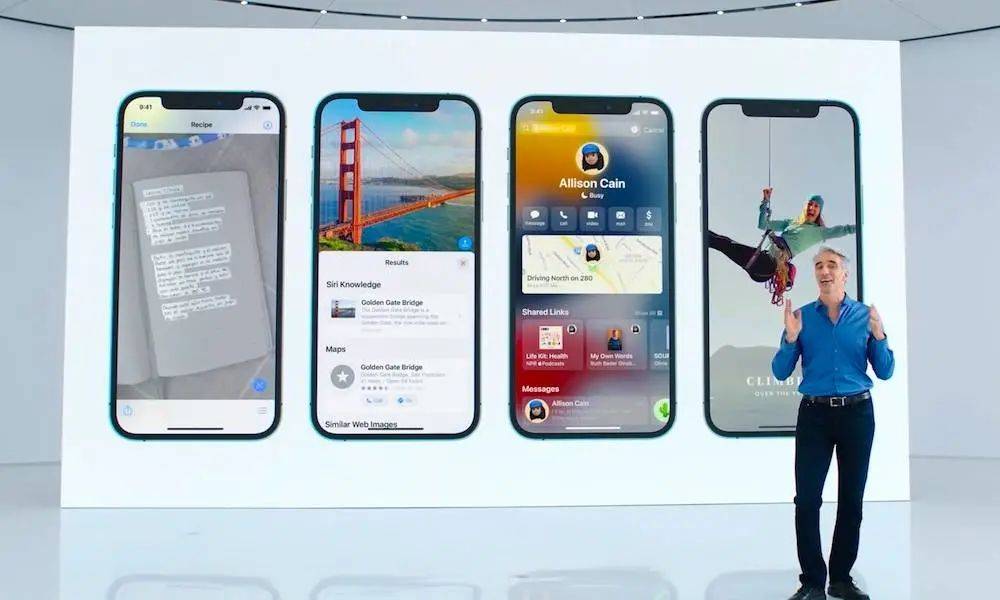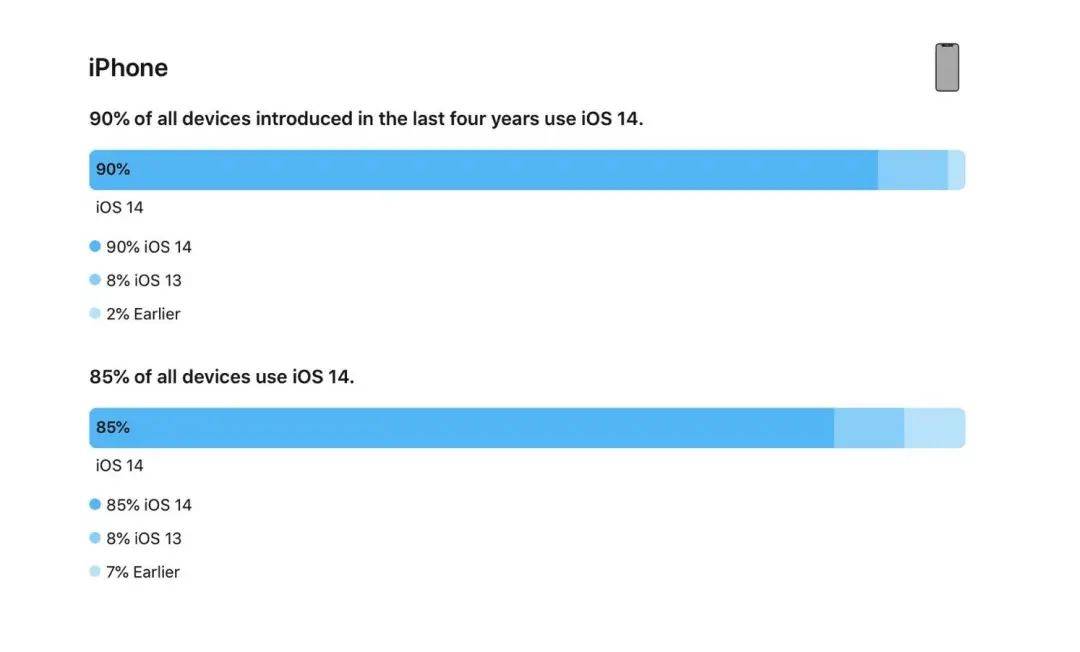Craig Federighi, Apple’s senior vice president of software engineering, said in an interview that iOS has a long list of agents every year, so it’s a headache when deciding which new features to add to iOS. After all, Apple has many creative and intelligent software engineers.

Take the just released iOS 15 as an example, the new system’s function upgrades are mostly soft upgrades around “sharing and connection between people”, which is more in line with the needs of many people today. On the other hand, most of the improvements in the iOS 15 interface are details, and there are not many highlights, and some are uninteresting.
I think that when deciding on the new features of iOS 15, Craig finally chose the most suitable for the needs of the moment among a bunch of new features, and lowered the priority of these features in the new design interface. But even so, after the iOS 15 Beta version went live, everyone’s enthusiasm for upgrading remains unabated.
What exactly is the upgrade system?
As the iPhone continues to sell well, there are hundreds of millions of iPhones on the market. The huge number of terminals makes iOS gradually become one of the mainstream mobile systems. At the same time, Apple’s iOS-based services are also increasing.

Apple Arcade game subscription service. Picture from: Apple
In addition to the App Store, iOS also has a number of streaming media services such as Apple Music, Apple News+, Apple Arcade, and Apple TV+, covering almost all aspects of music, games, reading, and video. The iOS device has almost become a distribution platform for various services.
But in order for these services to be better introduced to the terminal, there must be a prerequisite for maintaining the update rate of the terminal system. When looking at the page on Apple’s official website that introduces the iOS package of services, there will often be a small line “make sure that it has the latest version of iOS or iPadOS, macOS, or tvOS”. To put it bluntly, your device must be updated to the latest system. In order to use these latest services.

According to the data shared by Apple before WWDC, 90% of the iPhones launched in the past four years have iOS 14 installed, and if the sample is expanded to all iPhones, this proportion is also as high as 85%, which is already quite the number. It’s amazing, the Android next door “is greedy and crying.”
And 15% of those who have not installed iOS 14 include devices that cannot run the new system, that is, the processor is lower than the A9 chip. If iPadOS is also counted as a sub-category of iOS, the proportion of iPads with iPadOS 14 installed is 79%, which is lower than that of the iPhone. However, considering that the iPad has a longer life cycle and is mostly used for entertainment, it has such a high installation rate. It’s a very good result.

iOS 14.
Judging from these data, iOS 14 has a very high installation rate. If you round up, almost every iPhone will be upgraded to the latest iOS 14. System fragmentation seems to be a non-existent problem for iOS.
Taking a long view, in recent years, every generation of iOS systems has a very high upgrade rate, such as iOS 13 reaching 77%, iOS 12 reaching 80%, and iOS 11 reaching 85%. It is worth noting that within a few months after the release of the new system, the installation rate of the new iOS system will quickly climb to 50%.
Apart from the factory pre-installation of the new iPhone, there are also some other factors. The fundamental point is to repair system vulnerabilities and fix system bugs, as well as introduce new functions and services.

However, considering the necessity, in order to ensure system security, it is necessary to upgrade the new system to repair vulnerabilities and bugs. After all, smart phones have become the center of life, and basically everything is around it. The loopholes in the system can be easily exploited, thereby revealing privacy or being exploited by those who are interested.
And system bugs will bring inconvenience to daily use. In fact, regardless of iOS or Android, when each major version number is updated, there will be some system bugs, and many minor versions will be used to fix them in order to avoid affecting daily use.

“Flat” iOS 7 and “Imitated” iOS 6. Image from: hipertextual
Up to now, iOS has gone through nearly 15 years, and overall it has matured. Recently, the function changes of the new iOS are mostly on the details. It is difficult to see that the iOS 6 to iOS 7 changed from “quasi-object” to ” A great leap forward in “flat” style.
From this point of view, the small functions and small designs of the new system no longer have such a big motivation to encourage people to upgrade, but are replaced by new services.
As mentioned above, new services such as Apple Music and Apple Arcade will often rely on new system versions. Take the recent ALAC lossless audio and Dolby Atmos features, it requires iOS update to 14.6. Subsequent new systems may have more articles on the diversity of their own services.
The motivation for system upgrades has quietly changed
In the past, system updates were mostly a proactive behavior. That is, the user knows the new system, and actively goes to the settings to check and receive OTA push, and then restart to complete the upgrade. Or, after receiving the new system push, the system prompts the user to upgrade.

But from now on, iOS and many customized Android systems have opened the “Senseless Upgrade”, which automatically downloads the OTA update package at leisure or at night to complete the “Senseless” upgrade.
Apple introduced the “Automatic Update” function in iOS 12, and it is turned on by default. Whether it is iOS, iPadOS or macOS, there are such options. This is why many people wake up overnight and “renew” their iPhone next to their pillow. .
This was originally a very thoughtful function, especially when repairing sudden system vulnerabilities, it can be repaired quickly in time, which is also quite necessary for users. It’s just that there are too many bugs in the new iOS system, especially the frequency reduction problem of iOS 14.5.1. The “automatic update” function is undoubtedly annoying.

Speaking of the drastic decline in the stability of the new iOS system, we cannot fail to mention Apple’s “timely” shutdown verification of the old system version. Take iOS 14.5.1 as an example. After Apple launched iOS 14.5.1, it simply turned off the signature verification of iOS 14.5.
In the face of an iPhone that is experiencing a “Schrodinger” frequency reduction, you must either endure the frequency reduction and wait for the iOS 14.6 official version to be released, or upgrade to the more unstable Beta version, which is really a dilemma.
Turn off the signature verification of the old system prematurely to prevent the “rollback” of the device system. The original purpose was to prevent the use of lower version iOS vulnerabilities to break through the iPhone. The original intention was to be safe.

Picture from: ipertino.com
However, recent different voices about maintaining a high installation rate for the new iOS system are also based on Apple’s move. In other words, there are complaints about Apple’s overactive closure of the signature verification of the old version of iOS, and the belief that the new iOS system can Maintaining a high installation rate is related to this move.
In fact, there is no strong correlation between the two. First, upgrading through OTA is a very simple process, but downgrading requires backup and online brushing with the help of tools. The threshold is much higher, and it is not for ordinary users to operate. Or willing to learn and try.

Furthermore, some minor problems encountered after the iOS system upgrade do not affect everyone, or not everyone cares. In short, the early “closing” of the old system has little to do with the increase in the installation rate of the new iOS system.
In general, the official promotion of upgrades is actually focused on filling loopholes, fixing bugs, and new features and new services. As for the “small means” that appear to be more humane, they are auxiliary but not decisive factors.
When iOS was born, the biggest advantage was its maturity and stability. After years of evolution, it has covered more and more services and functions, and iOS has become more and more complex. Naturally, the size of the OTA installation package for each major iOS version is also increasing.

Picture from: consideringapple
With each update, the requirements for users have become higher, one is the network and the other is the capacity of the phone itself (that is, 64GB users).
To this end, when iOS 15 was released, Apple said that future updates might provide users with two options, to choose to get all the new features of iOS 15, or to choose to get only the security update of iOS 14. After the network or capacity is ready, go to get the full upgrade.
The starting point of such a move is the safety of the iOS system. In recent years, iOS has continuously emphasized “privacy protection”, and better privacy protection has become a unique feature of the iOS system.

Therefore, when we talk about “privacy”, I can think of the app tracking transparency feature brought by iOS 14.5, and I can also think of the new iCloud Private Relay feature on iOS 15. Perhaps in the future, there may be a “privacy” card for promoting system upgrades.
In the Internet world, a series of effective privacy protections are provided. Just as it sounds, people want to upgrade and update as soon as possible. After all, who doesn’t want “privacy” and who doesn’t want to be “invisible”?
In the final analysis, iOS has had a high installation rate before, and more of it relied on new features, new designs, and new features. In the future, when the installed capacity of iOS is large enough, providing new, interesting and diverse services will be the driving force to promote the upgrade of the new system.
Now, or on the new iOS system in the future, better “privacy protection” will be more likely to convince you to upgrade. However, no matter how the motivation for upgrading the new iOS system changes, the premise must be that the new system is sufficiently stable and mature.



























































You must log in to post a comment.